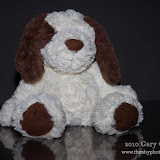So, as long as there is a wall, I bounce my speedlite
The problem arises when there is nothing to bounce off, like when I am outdoors. For these situations, I rely on my Lumiquest ProMax
The package includes the Lumiquest 80-20
What you do is put the Lumiquest 80-20 on your speedlite. The reason for the name is that 80% of the light will go up through the holes while 20% will be reflected back to the subject. The upward-bound light will serve as the ceiling bounce, but since there is 20% going towards the subject, the raccoon eyes will be eliminated.
If there is no ceiling, like when you are outside, you can use one of the inserts which attaches to the 80-20 via velcro. You can choose whichever bounce card you want, though I prefer to use the gold velcro when outdoors to give my subjects a warm complexion.
Finally, the diffuser will make the light softer further improving the quality of the light.
The problem with flash photography, used without caution, is that the flash tends to blow up spots on a subjects face. It also brings shadows into the picture which could mean a bad thing. (Of course the case would be different if you purposely want the picture to have shadows.) So what I recommend is bouncing the light. For this purpose, the Lumiquest ProMax is a very big help.
Note that the Lumiquest Cinch Strap
Highly Recommended.
You can buy the Lumiquest ProMax as a system or you can buy the parts individually:
Some sample shots using the Lumiquest ProMax. The shots with the straight flash were taken with -2 flash exposure compensation. The rest are taken with -1 flash exposure compensation. All shots were taken with the camera set on Manual with aperture of f/4, shutter speed at 1/250s, ISO100. The Canon 7D
For those without Flash:
 |
| Lumiquest ProMax System |





No comments:
Post a Comment